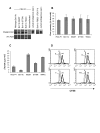Bcl11b mutations identified in murine lymphomas increase the proliferation rate of hematopoietic progenitor cells
- PMID: 17941976
- PMCID: PMC2140266
- DOI: 10.1186/1471-2407-7-195
Bcl11b mutations identified in murine lymphomas increase the proliferation rate of hematopoietic progenitor cells
Abstract
Background: The telomeric region of mouse chromosome 12 has previously shown frequent allelic loss in murine lymphoma. The Bcl11b gene has been identified and suggested as a candidate tumor suppressor gene within this region. In this study, we aimed to elucidate whether Bcl11b is mutated in lymphomas with allelic loss, and whether the mutations we detected conferred any effect on cell proliferation and apoptosis.
Methods: Mouse lymphomas induced by 1,3-butadiene or 2',3'-dideoxycytidine were analysed for mutations in the Bcl11b gene using single strand conformation analysis and direct DNA sequencing. Effects on cell proliferation by the detected mutations were studied by expressing wild-type and mutant Bcl11b in the cytokine-dependent hematopoietic progenitor cell line FDC-P1, lacking endogenous Bcl11b expression.
Results: Missense and frameshift (FS) mutations were identified in 7 of 47 tumors (15%). Interestingly, all mutations were found between amino acids 778-844 which encode the three C-terminal DNA-binding zinc fingers. In FDC-P1 cells, wild-type Bcl11b suppressed cell proliferation, whereas the mutated versions (S778N, K828T, Y844C and FS823) enhanced proliferation several-fold.
Conclusion: The genetic alterations detected in this study suggest that the three C-terminal zinc fingers of Bcl11b are important for the DNA-binding. Cell proliferation was suppressed by overexpression of wild-type Bcl11b but enhanced by mutant Bcl11b, indicating that these mutations may be an important contributing factor to lymphomagenesis in a subset of tumors.
Figures


Similar articles
-
Effect of Bcl11b genotypes and gamma-radiation on the development of mouse thymic lymphomas.Biochem Biophys Res Commun. 2008 Aug 22;373(2):282-5. doi: 10.1016/j.bbrc.2008.06.013. Epub 2008 Jun 17. Biochem Biophys Res Commun. 2008. PMID: 18558082
-
Haploinsufficiency of Bcl11b for suppression of lymphomagenesis and thymocyte development.Biochem Biophys Res Commun. 2007 Apr 6;355(2):538-42. doi: 10.1016/j.bbrc.2007.02.003. Epub 2007 Feb 8. Biochem Biophys Res Commun. 2007. PMID: 17306224
-
BCL11B mutations in patients affected by a neurodevelopmental disorder with reduced type 2 innate lymphoid cells.Brain. 2018 Aug 1;141(8):2299-2311. doi: 10.1093/brain/awy173. Brain. 2018. PMID: 29985992 Free PMC article.
-
Role of the transcription factor Bcl11b in development and lymphomagenesis.Proc Jpn Acad Ser B Phys Biol Sci. 2012;88(3):72-87. doi: 10.2183/pjab.88.72. Proc Jpn Acad Ser B Phys Biol Sci. 2012. PMID: 22450536 Free PMC article. Review.
-
Pivotal role of BCL11B in the immune, hematopoietic and nervous systems: a review of the BCL11B-associated phenotypes from the genetic perspective.Genes Immun. 2024 Jun;25(3):232-241. doi: 10.1038/s41435-024-00263-w. Epub 2024 Mar 12. Genes Immun. 2024. PMID: 38472338 Free PMC article. Review.
Cited by
-
The DN2 Myeloid-T (DN2mt) Progenitor is a Target Cell for Leukemic Transformation by the TLX1 Oncogene.J Bone Marrow Res. 2013 Feb 20;1:105. doi: 10.4172/2329-8820.1000105. J Bone Marrow Res. 2013. PMID: 25309961 Free PMC article.
-
Analysis of the expression of PHTF1 and related genes in acute lymphoblastic leukemia.Cancer Cell Int. 2015 Oct 5;15:93. doi: 10.1186/s12935-015-0242-9. eCollection 2015. Cancer Cell Int. 2015. PMID: 26448723 Free PMC article.
-
Increased expression of bcl11b leads to chemoresistance accompanied by G1 accumulation.PLoS One. 2010 Sep 2;5(9):e12532. doi: 10.1371/journal.pone.0012532. PLoS One. 2010. PMID: 20824091 Free PMC article.
-
A survey of well conserved families of C2H2 zinc-finger genes in Daphnia.BMC Genomics. 2010 Apr 30;11:276. doi: 10.1186/1471-2164-11-276. BMC Genomics. 2010. PMID: 20433734 Free PMC article.
-
Downregulation of BCL11A by siRNA induces apoptosis in B lymphoma cell lines.Biomed Rep. 2013 Jan;1(1):47-52. doi: 10.3892/br.2012.9. Epub 2012 Sep 5. Biomed Rep. 2013. PMID: 24648892 Free PMC article.
References
-
- Satterwhite E, Sonoki T, Willis TG, Harder L, Nowak R, Arriola EL, Liu H, Price HP, Gesk S, Steinemann D, Schlegelberger B, Oscier DG, Siebert R, Tucker PW, Dyer MJ. The BCL11 gene family: involvement of BCL11A in lymphoid malignancies. Blood. 2001;98:3413–3420. doi: 10.1182/blood.V98.12.3413. - DOI - PubMed
-
- Nagel S, Kaufmann M, Drexler HG, MacLeod RA. The cardiac homeobox gene NKX2-5 is deregulated by juxtaposition with BCL11B in pediatric T-ALL cell lines via a novel t(5;14)(q35.1;q32.2) Cancer research. 2003;63:5329–5334. - PubMed
-
- Bernard OA, Busson-LeConiat M, Ballerini P, Mauchauffe M, Della Valle V, Monni R, Nguyen Khac F, Mercher T, Penard-Lacronique V, Pasturaud P, Gressin L, Heilig R, Daniel MT, Lessard M, Berger R. A new recurrent and specific cryptic translocation, t(5;14)(q35;q32), is associated with expression of the Hox11L2 gene in T acute lymphoblastic leukemia. Leukemia. 2001;15:1495–1504. doi: 10.1038/sj.leu.2402249. - DOI - PubMed
Publication types
MeSH terms
Substances
LinkOut - more resources
Full Text Sources
Medical

